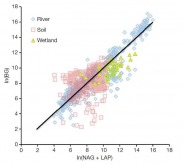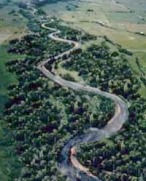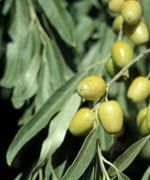CURRENT RESEARCH
Lotic ecosystem metabolic response to increased temperature

Many studies have been conducted to better predict the effects of global warming on soil carbon (C) storage and flux, but comparatively little research has been done to understand how C dynamics in freshwater ecosystems will respond to rising temperature. In streams and rivers, relationships between water temperature and metabolic processes are often confounded by fluctuation in hydrology and resource supply (e.g., light, C). With funding from the National Science Foundation, colleagues and I have found that the effects of temperature on metabolism can be isolated from the effects of other environmental factors using metabolic scaling theory and kinetics models (Follstad Shah et al. In preparation_b). Using meta-analyses of whole-stream metabolism in streams and rivers, we estimated that gross primary production and ecosystem respiration will increase within individual systems by 0.09-0.16 g C m-2 d-1 and 0.21-0.73 C m-2 d-1, respectively, with a 3˚C increase in mean annual water temperature (all other factors being equal). On a global scale, this translates to a decrease in C export from rivers to oceans by as little as 0.02-0.03 Pg C y-1 or as much as 0.24-0.33 Pg C y-1 in response to global warming. However, these estimates remain uncertain, largely due the number of indirect effects of climate change not included in existing models. One of my long-term research goals is to better understand not only the direct effect of temperature on riverine C budgets, but also to better understand and quantify the effects global warming will have on stream hydrology, dissolved and particulate C dynamics, and the supply of light that is often controlled by the phenology of riparian vegetation.
Scaling of ecoenzyme activity ratios and organic matter decomposition

Extracellular enzyme (ecoenzyme) expression is a product of heterotrophic metabolism regulated by the threshold element ratio (TER) of organic matter (OM). (TER is the critical C:P or C:N ratio at which metabolic control of an ecosystem switches from energy flow, represented by C, to a limiting nutrient flow, represented by phosphorus [P] or nitrogen [N].) Therefore, EEA ratios can be used to link metabolic scaling theory and ecological stoichiometry (Sinsabaugh et al. 2009). With support from the National Science Foundation, colleagues and I recently analyzed the activities of 4 ecoenzymes produced by heterotrophic microbial communities in soil and freshwater sediments and found that the ratio of activity associated with C:N:P acquisition was close to 1:1:1 in all habitats (Sinsabaugh et al. 2009), despite differences in community composition. We extended this analysis to consider the effect of OM recalcitrance (Sinsabaugh and Follstad Shah In review) and found that C demand increases more rapidly than N and P demand as soil OM recalcitrance increases, thus reducing microbial assimilation efficiencies for N and P and increasing N and P mineralization. Because ecoenzymatic activities (EEA) are related to both resource availability and microbial growth on the same spatiotemporal scale, analyses of these activities and their incorporation into ecological models may be used to resolve thermodynamic, energetic, and nutrient constraints on decomposition that will help to improve predictive models. We are actively pursuing funding to examine whether the temperature dependence and magnitude of ecoenzyme activities can be used to predict decomposition and mineralization rates of soil C stores with rising temperature.
Effects of river and riparian restoration on lotic ecosystem metabolism and biogeochemistry

Roughly $1 billion is spent annually on river and riparian restoration in the U.S., but little had been known about general trends in river and riparian restoration practices prior to the efforts of the National River Restoration Science Synthesis project (Bernhardt et al. 2005, Bernhardt et al. 2007, Follstad Shah et al. 2007). This project synthesized and analyzed restoration data from 7 regions of the country and created one of the largest restoration databases of national scope. I was responsible for collecting and analyzing data for southwestern states (AZ, CO, NM, UT), for which (1) the most common types of restoration were riparian management, water quality management, in-stream habitat improvement, and flow modification; (2) conservative estimates of total restoration costs exceeded $500 million; and (3) monitoring was linked to 28 % of projects, as opposed to just 10 % nationwide (Follstad Shah et al. 2007). Unfortunately, the efficacy of restoration at regional or national scales was difficult to ascertain given the dearth of information contained within most datasets. Scientists are showing that stream restoration efforts are not significantly altering rates of stream metabolism and nutrient cycling relative to degraded systems (partially due to constraints at the watershed vs. reach scale). Can restoration practices be altered to improve ecosystem function?
Photo: The Provo River near Heber, Utah after restoration. Courtesy the Utah Reclamation, Conservation, and Mitigation Commission.
Photo: The Provo River near Heber, Utah after restoration. Courtesy the Utah Reclamation, Conservation, and Mitigation Commission.
Effects of flood regime and plant invasion on ecosystem processes within river corridors

Restoration projects often focus on flow modification and riparian management in the U.S. Southwest because many rivers in this region are highly regulated. Regulation contributes to declines in native plant populations and exacerbates the spread of nonnative plants. In this context, my colleagues and I examined the effects of flood regime and species identity on riparian soil nitrogen (N) dynamics. We found a positive feedback between leaf litter production and soil N pools that is dampened by periodic inundation of mature riparian forests (Follstad Shah and Dahm 2008). Nonnative Tamarix sp. (salt cedar) was functionally similar to native Populus deltoides ssp. wislizeni (Rio Grande cottonwood) with regards to N consumption, allocation to tissues, and inputs to riparian soils (Follstad Shah and Dahm 2008, Follstad Shah et al. In preparation_a). In contrast, leaf fall from nonnative Elaeagnus angustifolia (Russian olive - a N2-fixer) had greater N content than that of P. deltoides and was highly correlated with soil N pools within P. deltoides study sites (Follstad Shah et al. 2010). These studies show that the global changes of river regulation and biotic homogenization alter N cycling, but effects of biotic homogenization depend on differences in species traits. The range of E. angustifolia continues to expand throughout the western U.S. and evidence is growing that it is altering riparian soil N dynamics. Is there a correlation between the cover of this species along streams and rivers and the N concentration of surface waters? If so, does removal of E. angustifolia reduce N loads?
Photo: Elaeagnus angustifolia (Russian olive) leaves and fruit. Courtesy the U.S. Bureau of Land Management.
Photo: Elaeagnus angustifolia (Russian olive) leaves and fruit. Courtesy the U.S. Bureau of Land Management.
